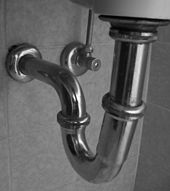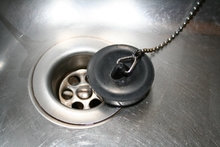Odor trap

An odor trap or siphon ( loan from the French siphon , siphon ; from Latin sīpho to ancient Greek σίφων síphōn , [water] pipe ) or trap (from English trap , the trap ) is an odor - or gas - tight , but liquid - permeable closure of pipe systems and vessels. The functional principle is based on an S-shaped pipe , the lower bend of which is always filled with liquid and thus prevents the passage of duct gases .
Most common use of the siphon is the trap of sewers in households and businesses, especially in sinks , toilets , sinks and drains . This prevents malodorous gases from escaping from the sewer system into the building. The prerequisite is that the house's sewer pipe is ventilated elsewhere, usually via the roof, so that no negative pressure can arise in the sewer system that would lead to the suction of the sealing water.
history
As early as 230 BC This pipe system was known to the Greeks.
The inventor of the modern water closet , Alexander Cumming , is considered to be the inventor of the siphon ; the first patent was granted to the French Benoist in Paris on June 19, 1823 .
Odor traps in the house installation
There are four types according to their design:
- Tubular siphon , the simplest type with a U-shaped drainage pipe
- Bottle siphon , the vertical drain is immersed in a cup, which fills first before the water runs over the edge of the cup into the actual drain; takes up less space than the pipe siphon, but clogs up faster
- Cup siphons , such as the bottle siphon with a smaller installation depth, are therefore used, for example, in shower channels in floor-level showers
- Diving wall closure
- Bell odor trap
- Dry siphon, additionally contains a ball or a flap, which ensures a seal even after the siphon has dried out when the drain is not in use.
Another design, e.g. B. in urinals , is the suction siphon . It works on the siphon principle and draws the waste water into the drain pipe with a significant negative pressure.
The siphons of waterless urinals are specially designed. Depending on the design, they contain a float, a liquid- permeable membrane or a special barrier liquid that is retained within the siphon.
In Germany the water seal height of all odor traps is standardized according to DIN 1986-100. For rainwater drains it is 100 mm, for dirty water drains 50 mm.
In the case of siphons that are seldom used (for example in condensing boilers and ventilation devices, where condensate usually only accumulates in the winter months and is discharged through the siphon), the water evaporates over time so that there is no longer an odor seal. Remedy
- refill the water regularly,
- adding a small amount of cooking oil or glycerine to the drain to prevent the sealing water from evaporating, or
- to use a special dry siphon in which either the evaporation of the sealing water or the escape of odors is structurally excluded.
In addition, sludge and sediments tend to collect at the bottom of the odor trap, so that the permeability decreases to the point of clogging: regular maintenance and control prevents this. Chemical solvents pollute the sewage system and sewage treatment plants. If necessary, the pipe system must be dismantled for cleaning; very old siphons made of lead or cast iron that cannot be dismantled usually have a cleaning opening at the bend that is closed with a screw. If solid parts such as jewelry or the like accidentally get into the drain, they may be found in the odor trap.
Other uses
Gas closures in fermentation tanks or wine barrels work according to the same principle during the fermentation process (see also fermentation tubes ) as well as in a variety of other chemical processes in the absence of air, in which gases are generated that can escape through the siphon. In the case of sauerkraut pots , an all-round channel filled with water, into which the edge of the lid dips, forms a siphon.
The ball siphon is suitable for draining air conditioning units and duct coolers with negative pressure in relation to the environment. It fills automatically and prevents emptying in the event of pressure surges.
See also
- Mönch (pond management) , opposite, siphon-like water overflow
Web links
Individual evidence
- ↑ The siphonic toilet. An illustrated guide to the siphonic flush. In: ToiletVision.com. October 6, 2019, Retrieved December 22, 2019 (American English).
- ↑ Nina Sedano: Happy End . ISBN 978-3-944296-94-4 .
- ↑ Bruno Bosy: Explanation of the dry siphon in: Haustechnikdialog.de




